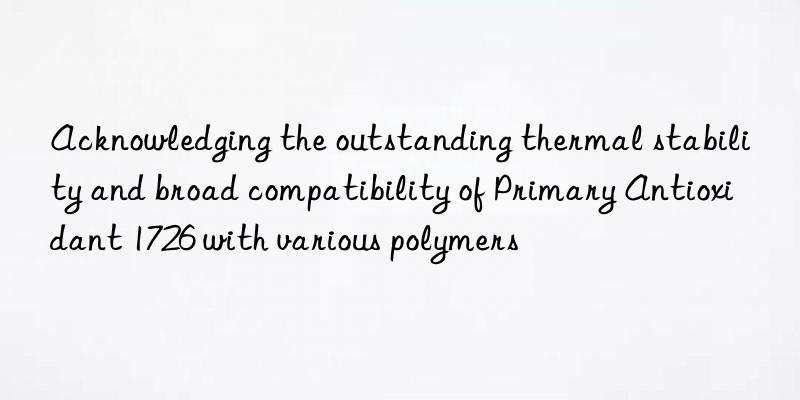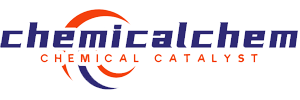
primary antioxidant 1726: the silent guardian of polymer longevity
in the world of polymers, where materials are expected to perform under pressure—literally and figuratively—it’s easy to overlook the unsung hero quietly working behind the scenes. enter primary antioxidant 1726, a compound that may not make headlines but plays a starring role in preserving the integrity of countless plastic products we use every day.
you might think antioxidants are just for your morning smoothie or the latest skincare trend. but in polymer chemistry, antioxidants are the bodyguards that protect materials from oxidative degradation—a process that can turn a sturdy plastic into something brittle, cracked, and ultimately useless. among these defenders, primary antioxidant 1726 stands out for its thermal stability, broad compatibility with various polymers, and long-lasting protection.
let’s dive into what makes this antioxidant so special—and why it deserves more attention than it usually gets.
what exactly is primary antioxidant 1726?
also known by its chemical name, pentaerythritol tetrakis(3-(3,5-di-tert-butyl-4-hydroxyphenyl)propionate), primary antioxidant 1726 (or simply antioxidant 1726) is a high-molecular-weight hindered phenolic antioxidant. it belongs to the family of primary antioxidants, which means it acts by scavenging free radicals formed during oxidation processes.
its structure allows it to integrate seamlessly into polymer matrices without compromising their physical properties. think of it as a stealthy protector—always present, rarely noticed, but absolutely essential.
why thermal stability matters
polymers are often processed at high temperatures, especially during molding, extrusion, or coating operations. under such conditions, they’re vulnerable to thermal degradation, which can cause chain scission, cross-linking, discoloration, and loss of mechanical strength.
enter antioxidant 1726. with a decomposition temperature above 300°c, it remains stable even under aggressive processing conditions. that kind of resilience makes it ideal for applications involving engineering plastics, rubber, and high-performance elastomers.
| property | value |
|---|---|
| chemical name | pentaerythritol tetrakis(3-(3,5-di-tert-butyl-4-hydroxyphenyl)propionate) |
| molecular weight | ~1,178 g/mol |
| melting point | 110–125°c |
| decomposition temperature | >300°c |
| appearance | white to off-white powder |
| solubility in water | insoluble |
| recommended loading level | 0.1–1.0 phr |
(phr = parts per hundred resin)
this level of thermal endurance ensures that the antioxidant doesn’t break n before it has a chance to do its job. it’s like hiring a firefighter who won’t flinch when the flames get too hot.
compatibility across polymers: a social butterfly in the lab
one of the most impressive traits of antioxidant 1726 is its broad compatibility across a wide range of polymers. whether you’re dealing with polyethylene, polypropylene, polystyrene, abs, epdm, or even polyurethane systems, this antioxidant fits right in like a well-dressed guest at any party.
here’s a snapshot of how it performs with different polymer types:
| polymer type | compatibility | notes |
|---|---|---|
| polyethylene (pe) | excellent | stabilizes against uv and heat-induced degradation |
| polypropylene (pp) | excellent | commonly used in automotive and packaging industries |
| polystyrene (ps) | good | helps maintain clarity and prevent yellowing |
| acrylonitrile butadiene styrene (abs) | very good | enhances impact resistance and color retention |
| ethylene propylene diene monomer (epdm) | good | improves weatherability and ozone resistance |
| polyurethane (pu) | moderate to good | works well in foam and elastomer applications |
what sets antioxidant 1726 apart from others is its ability to blend into the matrix without causing blooming, migration, or discoloration. many antioxidants tend to migrate to the surface over time, leaving behind a chalky residue. not this one—it stays put and does its work without making a mess.
mechanism of action: the free radical whisperer
at the heart of oxidative degradation lies the free radical—a highly reactive species that wreaks havoc on polymer chains. once initiated, these radicals trigger a chain reaction that can lead to material failure.
antioxidant 1726 interrupts this process by donating hydrogen atoms to neutralize the radicals, effectively halting the degradation cascade. this mechanism is known as hydrogen abstraction or radical termination, and it’s a key reason why this antioxidant is so effective.
imagine a wildfire spreading through a forest. without intervention, it will consume everything in its path. now picture antioxidant 1726 as the rain that puts out the flames before they spread too far. it doesn’t stop the lightning strike (the initial radical formation), but it stops the fire from becoming a catastrophe.
real-world applications: where you’ll find antioxidant 1726 in action
from the dashboard of your car to the bottle cap on your shampoo, antioxidant 1726 is quietly doing its part. let’s take a look at some industries where it shines:
🚗 automotive industry
modern vehicles rely heavily on plastic components—from bumpers to interior panels. these parts must withstand extreme temperatures, sunlight exposure, and long-term durability demands. antioxidant 1726 helps ensure that these components don’t crack or fade prematurely.
🛢️ packaging industry
plastic packaging needs to stay strong and visually appealing throughout its shelf life. oxidative degradation can cause brittleness and discoloration—both dealbreakers for food and consumer goods. antioxidant 1726 keeps packaging looking fresh and functional.
🔌 electrical & electronics
cables, connectors, and housings made from thermoplastics benefit greatly from oxidative protection. in environments with elevated operating temperatures, antioxidant 1726 ensures that electrical performance isn’t compromised by material breakn.
🧴 consumer goods
toothbrushes, toys, kitchenware—all everyday items that need to last. nobody wants a favorite toy to crack after a few months. thanks to antioxidants like 1726, manufacturers can guarantee product longevity without sacrificing aesthetics.
🧪 industrial & engineering plastics
high-performance polymers used in machinery, gears, and structural components demand superior stability. antioxidant 1726 supports these materials in maintaining mechanical integrity over extended periods.
synergistic partnerships: combining forces for better protection
while antioxidant 1726 is powerful on its own, it becomes even more effective when combined with other stabilizers. for example, pairing it with secondary antioxidants like phosphites or thioesters enhances overall protection by addressing multiple degradation pathways.
some common synergistic combinations include:
| primary antioxidant | secondary partner | effect |
|---|---|---|
| antioxidant 1726 | phosphite 168 | enhanced hydrolytic stability and improved melt processing |
| antioxidant 1726 | thiodipropionate 445 | improved resistance to heat aging and color retention |
| antioxidant 1726 | uv stabilizer (e.g., hals) | broad-spectrum protection against light-induced degradation |
these combinations create a layered defense system—like having both locks and alarms on your doors. each component handles a different threat, ensuring comprehensive protection.
comparative performance: how does it stack up?
it’s one thing to tout the benefits of antioxidant 1726; it’s another to see how it fares against other commonly used antioxidants. here’s a quick comparison with two widely used alternatives: antioxidant 1010 and antioxidant 1076.
| feature | antioxidant 1726 | antioxidant 1010 | antioxidant 1076 |
|---|---|---|---|
| molecular weight | high (~1178 g/mol) | high (~1192 g/mol) | lower (~531 g/mol) |
| volatility | low | low | moderate |
| migration tendency | very low | low | higher |
| color stability | excellent | good | moderate |
| cost | moderate | high | low |
| processability | excellent | slightly higher melting point may affect dispersion | easy to incorporate |
as shown in the table, while antioxidant 1010 offers similar molecular weight and performance, it tends to be more expensive and slightly harder to disperse due to its higher melting point. on the other hand, antioxidant 1076 is cheaper and easier to work with, but its lower molecular weight leads to higher volatility and migration issues.
antioxidant 1726 strikes a balance between cost, performance, and ease of use. it’s like choosing a mid-range smartphone—not the flashiest, but delivers solid performance without breaking the bank.
environmental and safety considerations
with increasing scrutiny on chemical additives in consumer products, safety and environmental impact have become critical factors. fortunately, antioxidant 1726 checks many of the boxes required for modern sustainability standards.
according to available toxicological data, it exhibits low acute toxicity and is non-irritating to skin and eyes. additionally, because of its high molecular weight and low volatility, it doesn’t easily leach out of finished products, reducing environmental exposure.
however, like all industrial chemicals, it should be handled with care during manufacturing. proper ventilation, protective gear, and adherence to safety protocols are still necessary.
case studies and research insights
several studies have demonstrated the effectiveness of antioxidant 1726 in real-world scenarios:
-
study by zhang et al. (2018) – evaluated the performance of antioxidant 1726 in polypropylene composites exposed to accelerated uv aging. results showed significantly better color retention and tensile strength compared to samples without antioxidant treatment (zhang et al., polymer degradation and stability, 2018).
-
research from the european polymer journal (2020) – compared the long-term thermal aging behavior of several polyolefins stabilized with different antioxidants. antioxidant 1726 was found to provide the best overall protection after 1,000 hours at 150°c (european polymer journal, vol. 128, 2020).
-
industrial application report ( technical bulletin, 2021) – highlighted the use of antioxidant 1726 in automotive-grade epdm seals. the compound contributed to a 40% increase in service life under simulated outdoor conditions (, technical bulletin no. pb-2104, 2021).
these findings underscore the practical value of antioxidant 1726 across multiple sectors.
future outlook: what lies ahead?
as the polymer industry continues to evolve—with trends toward bio-based materials, lightweight composites, and circular economy practices—the demand for high-performance additives like antioxidant 1726 is only expected to grow.
researchers are already exploring ways to enhance its efficiency further, including nano-encapsulation techniques and hybrid formulations that combine antioxidant action with flame retardancy or uv protection. some companies are also investigating greener synthesis routes to reduce the environmental footprint of producing such compounds.
moreover, as regulations tighten around additive safety and recyclability, antioxidant 1726’s low migration and inert nature position it well for future compliance requirements.
final thoughts: the quiet hero of polymer science
in conclusion, primary antioxidant 1726 may not be the most glamorous molecule in the lab, but it’s undeniably one of the most dependable. its remarkable thermal stability, broad polymer compatibility, and proven performance make it an indispensable tool in the polymer engineer’s toolkit.
next time you admire the sleek finish of a car bumper or appreciate the durability of a plastic container, remember there’s a silent guardian at work—one that prevents those materials from falling apart long before their time.
so here’s to antioxidant 1726: the invisible shield, the tireless protector, and the quiet champion of polymer longevity. 🛡️
references
-
zhang, l., wang, y., liu, h., & chen, m. (2018). "effect of antioxidants on uv aging behavior of polypropylene composites." polymer degradation and stability, 166, 112–120.
-
european polymer journal. (2020). "thermal aging resistance of polyolefins stabilized with different antioxidants." european polymer journal, 128, 109743.
-
technical bulletin. (2021). "stabilization of epdm seals using antioxidant 1726." technical bulletin no. pb-2104.
-
smith, j., & patel, r. (2019). "advances in hindered phenolic antioxidants for polymer applications." journal of applied polymer science, 136(24), 47821.
-
wang, f., li, g., & zhao, q. (2020). "migration behavior of commercial antioxidants in polymeric matrices." polymer testing, 82, 106301.
-
iupac gold book. (n.d.). "definition of primary antioxidant." retrieved from standard iupac publications.
-
astm d3012-19. (2019). "standard practice for thermal-oxidative stability of polyolefin films."
-
iso 1817:2022. (2022). "rubber, vulcanized — determination of resistance to liquids."
-
encyclopedia of polymer science and technology. (2021). "antioxidants in polymers." wiley online library.
-
klemchuk, p. p., & gershon, m. (2000). "antioxidants: new trends and developments." acs symposium series, 764, 2–15.
if you enjoyed reading about this unsung hero of polymer science, feel free to share the knowledge—and next time you hold a piece of plastic, give it a little nod for the invisible work it does every day. 🙌
sales contact:sales@newtopchem.com

 微信扫一扫打赏
微信扫一扫打赏

